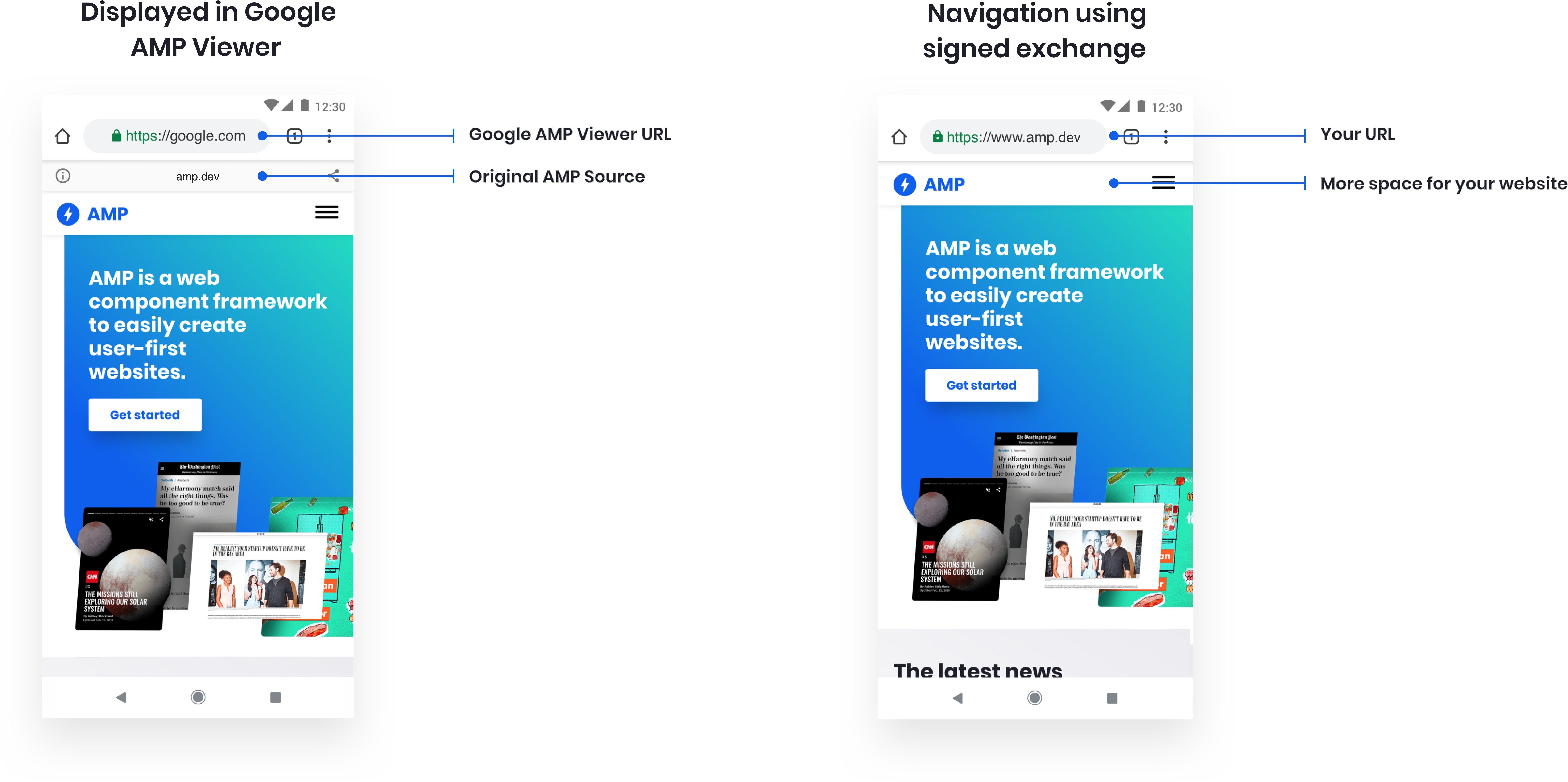التعرّف على طريقة عمل صفحات AMP في نتائج البحث
يفهرس "بحث Google" صفحات AMP لتقديم تجربة ويب سريعة وموثوقة. وفي حال توفُّر صفحة AMP، يمكن عرضها على "بحث الجوّال" كجزء من النتائج الغنية بصريًا ولوحات العرض الدوّارة. لا يمكن اعتبار صفحات AMP بحد ذاتها عامل ترتيب، ولكن السرعة هي أحد عوامل الترتيب في "بحث Google". يستخدم محرّك بحث Google المعيار نفسه في جميع الصفحات، بغضّ النظر عن التقنية المستخدمة في تصميم الصفحة. للحصول على معلومات عن مزايا استخدام صفحات AMP، يمكنك الاطّلاع على قصص النجاح في "مشروع AMP".
عندما يختار المستخدمون صفحة AMP، يستردّ محرّك بحث Google الصفحة من ذاكرة التخزين المؤقت لصفحات AMP على Google، ما يتيح خيارات متنوعة من تحسينات التحميل التي تجعل هذه الصفحات تظهر عادةً بشكل فوري، كخيار العرض المسبق. لا يتم عرض صفحات AMP على أجهزة الكمبيوتر المكتبي في الوقت الحالي من "ذاكرة التخزين المؤقت لصفحات AMP على Google" أو "عارِض صفحات AMP". تنتهج صفحات AMP الأساسية سلوكًا مماثلاً لسلوك النتائج العادية.
العرض المبدئي في نتائج "بحث Google"
يمكن أن تظهر صفحات AMP في "بحث Google" على أنّها نتيجة غنية بصريًا، على غرار الصفحات الأخرى على الويب. ولمساعدة Google على فهم صفحتك بشكل أفضل، يمكنك إضافة بيانات منظَّمة إلى صفحتك. يُرجى العلم أنّ Google لا تضمن ظهور الصفحة كنتيجة غنية بصريًا في نتائج "بحث Google" عند إضافة بيانات منظَّمة. للحصول على مزيد من المعلومات، يمكنك الاطّلاع على الإرشادات العامة المتعلقة بالبيانات المنظَّمة.
في حال وجود صفحات مكرّرة للمحتوى نفسه، ننصح بإدراج البيانات المنظَّمة نفسها في جميع الصفحات المكرّرة وليس في الصفحة الأساسية فقط. ولمزيد من المعلومات حول إدراج البيانات المنظَّمة، يُرجى الاطّلاع على الإرشادات العامة للبيانات المنظَّمة.
يمكن أن تظهر صفحات AMP أيضًا على شكل "قصص الويب". اطّلِع على المزيد من المعلومات حول كيفية تفعيل "قصص الويب" على "بحث Google".
بعد نقر المستخدمين على محتوى AMP
عندما ينقر المستخدمون على محتوى AMP في "بحث Google"، يمكن أن يظهر محتوى AMP بإحدى الطريقتين التاليتين:
- عارِض صفحات AMP من Google: في أعلى عارِض صفحات AMP من Google، يتم عرض نطاق المحتوى حتى يتمكن المستخدمون من معرفة مَن نشره.
- Signed Exchange: هي تكنولوجيا تتيح للمتصفح التعامل مع المستند على أنه تابع للمصدر الخاص بك.

معلومات عن "عارض صفحات AMP من Google"
"عارِض صفحات AMP من Google" هو بيئة مختلطة لجمع بيانات عن المستخدم في المتصفحات التي تتوافق مع "عارِض صفحات AMP من Google". يمكن أن يتم تفعيل "عارِض صفحات AMP من Google" عندما تحدّد أنظمتنا أنّها يمكن أن تقدّم تجربة مفيدة للمستخدم، خصوصًا إذا كان من المتوقّع أن يمرّر المستخدم سريعًا في المحتوى. وتخضع آلية Google في جمع البيانات لسياسة الخصوصية السارية في Google. وإذا كنت تنشر صفحات AMP ويظهر المحتوى الذي تنشره على "عارض صفحات AMP من Google"، تخضع عملية جمع البيانات الخاصة بك لسياسة الخصوصية التي تحدّدها أنت. وتتحمّل مسؤولية الوفاء بالتزامات الامتثال التي تنشأ عن اختيارك للسلوكيات وعمليات دمج الموردين على صفحات AMP.
معلومات عن Signed Exchange
تتيح لك آلية Signed Exchange استخدام ملفات تعريف الارتباط الخاصة بالطرف الأول لتخصيص المحتوى وقياس الإحصاءات. تظهر صفحتك ضمن عنوان URL الخاص بك بدلاً من عنوان URL الخاص بـ google.com/amp.
يمنح "بحث Google" الأولوية لإدراج روابط تؤدي إلى المحتوى بتنسيق Signed Exchange على استخدام "عارِض صفحات AMP من Google"، وذلك في المتصفحات التي تتوافق مع Signed Exchange. لتقديم نتائج بهذا التنسيق للمستخدمين، يجب نشر محتوى AMP بتنسيق Signed Exchange بالإضافة إلى تنسيق "رمز HTML لصفحات AMP" العادي.
في الوقت الحالي، لا يتوافق تنسيق Signed Exchange إلا مع النتائج الغنية بصريًا والنتائج الأساسية في "بحث Google"، وليس مع لوحات العرض الدوّارة. للحصول على مزيد من المعلومات عن إعداد Signed Exchange في صفحات AMP، يمكنك الانتقال إلى
عرض صفحات AMP باستخدام Signed Exchange.
